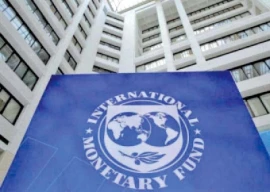
With the deposit rate at a seven-year low after the latest monetary policy announcement by the State Bank of Pakistan on June 21, the overall spread of the banking sector is likely to shrink to an average of 6% during the first half of fiscal 2014, according to banking sector analysts.
The banking sector spread is defined as the difference between banks’ cost of deposits and the interest they earn on advances.
The prediction comes immediately after a surprising month-on-month uptick of 15 basis points in the banking sector’s spread to 6.3%, according to a JS Global Capital research note written by analyst Bilal Qamar. While the average spread registered an increase on a monthly basis, it was down 73 basis points on a year-on-year basis. One percentage point is equal to 100 basis points.

Speaking to The Express Tribune, Foundation Securities analyst Syed Asad Ahmed said banking spreads will decrease going forward despite an expected surge in the consumer price index. His brokerage firm estimates that inflation will hover in the range of 9.5% and 10% in the fiscal year 2013-14, which may result in a higher deposit rate. An increase in the deposit rate will swell banks’ spreads, if the central bank decides to keep the minimum deposit rate at the current level of 6% per annum.
With regard to recent news reports that suggested the International Monetary Fund had expressed disappointment over the cut in the discount rate, Ahmed said a revision may be expected in the next monetary policy announcement due in two months.

The month-on-month increase in the banks’ spread is largely attributed to a slight increase in lending rates, which went up seven basis points to 11.49%, and a decline in deposit rates, which was down eight basis points month-on-month to 5.15%, according to JS Global Capital research note. “With a further cut in deposit rates, we anticipate banking spreads to average around 6% in the second half of 2013, putting additional pressure on core operations for banks,” it added.
Speaking to The Express Tribune, Global Securities research analyst Umair Naseer said the banks will have to focus on non-interest income in the future in view of continuously declining spreads. Fee, commission and brokerage income of banks – which fall under the ambit of non-interest income –contributed 13% to the total revenues of the banking sector during the first quarter of 2013.
“A cut in the discount rate is good for banks in a sense because that forces them to think out-of-the-box and come up with new products to make money in tough times,” Naseer said.
Published in The Express Tribune, June 27th, 2013.
Like Business on Facebook, follow @TribuneBiz on Twitter to stay informed and join in the conversation.
COMMENTS (2)
Comments are moderated and generally will be posted if they are on-topic and not abusive.
For more information, please see our Comments FAQ

















Yes u are right @ AR i think there is an error...
"An increase in the deposit rate will swell banks’ spreads, if the central bank decides to keep the minimum deposit rate at the current level of 6% per annum."
Umm, won't an increase in deposit rates further squeeze banks' spreads? And particularly so if the central bank sticks with its current minimum deposit rate?